4. Product Management
4.1. Introduction
As you grow your company, you are bringing more people in. You become concerned that they need to share the same vision that inspired you to create this company. This is the goal of product management as a formalized practice.
Product strategy was largely tacit in Part I. As the founder, you used product management and product discovery practices, and may well be familiar with the ideas here, but the assumption is that you did not explicitly formalize your approach to them. Now you need a more prescriptive and consistent approach to discovering, defining, designing, communicating, and executing a product vision across a diverse team.
In this chapter, we will define and discuss product management, and distinguish it from project and process management. We will cover how product teams are formed and what practices and attitudes you should establish quickly.
We will discuss a number of specific schools of thought and practices, including Gothelf’s Lean UX, Scrum, and more specific techniques for product “discovery.” Finally, we will discuss the concepts of design and design thinking.
4.1.1. Chapter 4 outline
-
Why product management?
-
The product vision
-
Defining product management
-
Process, project, and product management
-
Productization as a strategy at Amazon
-
-
Organizing the product team
-
The concept of collaboration
-
Lean UX
-
Scrum
-
More on product team roles
-
-
Product discovery
-
Formalizing product discovery
-
Product discovery techniques
-
Discovery and design
-
Design
-
-
Assorted topics in Product Management
4.1.2. Chapter 4 learning objectives
-
Define and distinguish product versus project and process management
-
Identify the key concerns of forming a collaborative product team
-
Describe current product-oriented practices, such as Lean UX and Scrum
-
Describe product design and discovery practices and concerns
4.2. Why product management?
4.2.1. The product vision
|
Note
|
You should review the digital context material in Chapter 1. |
Before work, before operations, there must be a vision of the product. You already established a preliminary vision in Chapter 1, but now as your organization grows, you need to consider further how you will sustain that vision and establish an ongoing capability for realizing it. Like many other topics in this book, product management is a significant field in and of itself. Historically, product management has not been a major theme in enterprise IT management. Digital changes this.
IT systems started by serving narrow purposes, often “back office” functions such as accounting or materials planning. Mostly, such systems were managed as projects assembled on a temporary basis, resulting in the creation of a system to be “thrown over the wall” to operations. Product management, on the other hand, is concerned with the entire lifecycle. The product manager (or owner, in Scrum terms) cares about the vision, its execution, the market reaction to the vision (even if an internal market), the health, care, and feeding of the product, and the product’s eventual sunset or replacement.
In the enterprise IT world, “third party” vendors (e.g.,IBM) providing the back-office systems had product management approaches, but these were external to the IT operations. Nor were IT-based product companies as numerous 40 years ago as they are today; as noted in Chapter 1, with digital transformation, the digital component of modern products continues to increase to the point where it’s often not clear whether a product is “IT” or not.
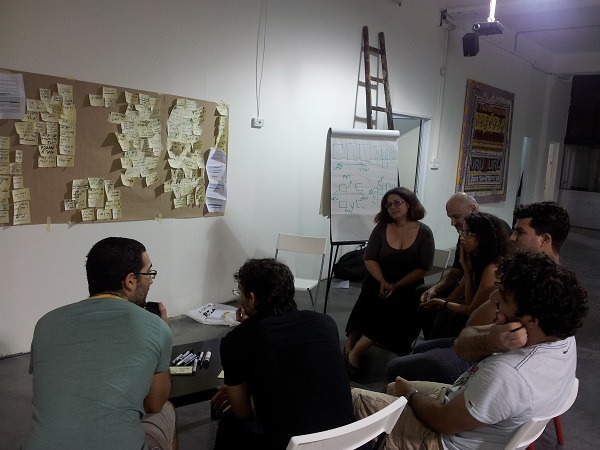
Reacting to market feedback and adapting product direction is an essential role of the product owner. In the older model, feedback was often unwelcome, as the project manager typically was committed to the open-loop dead reckoning of the project plan and changing scope or direction was seen as a failure, more often than not.
Now, it’s accepted that systems evolve, perhaps in unexpected directions. Rapidly testing, failing fast, learning, and pivoting direction are all part of the lexicon, at least for market-facing IT-based products. And even back-office IT systems with better understood scope are being managed more as systems (or products) with lifecycles, as opposed to transient projects. (See the Amazon discussion, below).
So, what is product management and what does it mean for your team? [1]
4.2.2. Defining product management
In order to define product management, we first need to define the product. In Chapter 1, we established that products are goods, services, or some combination, with some feature that provides value to some consumer. BusinessDictionary.com defines it thus:
[A Product is] A good, idea, method, information, object, or service created as a result of a process and serves a need or satisfies a want. It has a combination of tangible and intangible attributes (benefits, features, functions, uses) that a seller offers a buyer for purchase. For example, a seller of a toothbrush offers the physical product and also the idea that the consumer will be improving the health of their teeth. A good or service [must] closely meet the requirements of a particular market and yield enough profit to justify its continued existence.
Product management, according to the same source, is:
The organizational structure within a business that manages the development, marketing, and sale of a product or set of products throughout the product lifecycle. It encompasses the broad set of activities required to get the product to market and to support it thereafter.
Product management in the general sense often reports to the Chief Marketing Officer (CMO). It represents the fundamental strategy of the firm, in terms of its value proposition and viability. The product needs to reflect the enterprise’s strategy for creating and maintaining customers.
Product strategy for internally-facing products is usually not defined by the enterprise CMO. If it is a back-office product, then “business within a business” thinking may be appropriate. (Even the payroll system run by IT for HR is a “product,” in this view). In such cases, there still is a need for someone to function as an “internal CMO” to the external “customers.”
|
Note
|
As a field, product management has a professional association, the Product Development and Marketing Association, which publishes an extensive and continuously-refined handbook, and supports local chapters, training and certification, and other activities typical of a mature professional organization. |
With digital transformation, all kinds of products have increasing amounts of “IT” in them. This means that an understanding of IT, and ready access to any needed IT specialty skills, is increasingly important to the general field of product management. Product management includes research and development, which means that there is considerable uncertainty. This is of course also true of IT systems development.
Perhaps the most important aspect of product design is focusing on the user, and what they need. The concept of outcome is key. This is easier said than done. The general problem area is considered Marketing, a core business school topic. Entire books have been written about the various tools and techniques for doing this, from focus groups to ethnographic analysis.
However, Marty Cagan recommends distinguishing Product Management from Product Marketing. He defines the two as follows:
The product manager is responsible for defining—in detail—the product to be built and validating that product with real customers and users. The product marketing person is responsible for telling the world about that product, including positioning, messaging and pricing, managing the product launch, providing tools for the sales channel to market and sell the product, and for leading key programs such as online marketing and influencer marketing programs [50 pp. 10-11].
We discuss some criticisms of overly marketing-driven approaches below.
4.2.3. Process, project, and product management
In the remainder of this book, we will continually encounter three major topics:
-
Product Management (this chapter)
-
Process Management (covered in Chapter 7)
-
Project Management (covered in Chapters 7 and 8)
They have an important commonality: all of them are concepts for driving results across organizations. Here are some of the key differences between process, project, and product management in the context of digital services and systems:
| Process | Project | Product |
|---|---|---|
Task-oriented |
Deliverable oriented |
Outcome oriented |
Repeatable with a high degree of certainty |
Executable with a medium degree of certainty |
Significant component of research and development, less certain of outcome — empirical approaches required |
Fixed time duration, relatively brief (weeks/months) |
Limited time duration, often scoped to a year or less |
No specific time duration; lasts as long as there is a need |
Fixed in form, no changes usually tolerated |
Difficult to change scope or direction, unless specifically set up to accommodate |
Must accommodate market feedback and directional change |
Used to deliver service value and operate system (the “Ops” in DevOps) |
Often concerned with system design and construction, but typically not with operation (the “Dev” in DevOps) |
Includes service concept and system design, construction, operations, and retirement (both “Dev” and “Ops”) |
Process owners are concerned with adherence and continuous improvement of the process; otherwise can be narrow in perspective |
Project managers are trained in resource and timeline management, dependencies & scheduling; they are not typically incented to adopt a long-term perspective |
Product managers need to have project management skills as well as understanding market dynamics, feedback, building long-term organizational capability |
Resource availability and fungibility is assumed |
Resources are specifically planned for, but their commitment is temporary (team is “brought to the work”) |
Resources are assigned long-term to the product (work is “brought to the team”) |
The above distinctions are deliberately exaggerated, and there are of course exceptions (short projects, processes that take years). However, it is in the friction between these perspectives we see some of the major problems in modern IT management. For example, an activity which may be a one-time task or a repeatable process results in some work product—perhaps an artifact (see Activities create work products).

The consumer or stakeholder of that work product might be a Project Manager.
Project management includes concern for both the activities and the resources (people, assets, software) required to produce some deliverable (see Projects create deliverables with resources and activities).

The consumer of that deliverable might be a product manager. Product management includes concern for projects and their deliverables, and their ultimate outcomes, either in the external market or internally (see Product management may use projects).
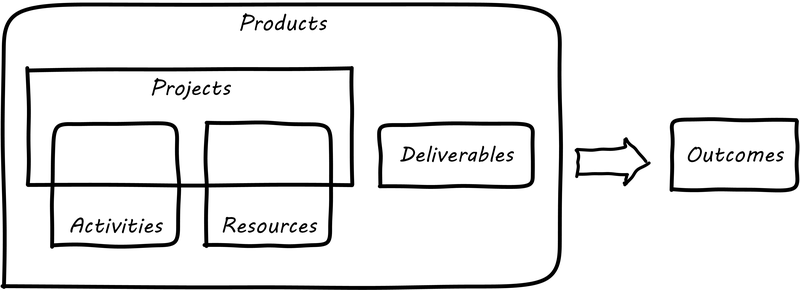
Notice that product management may directly access activities and resources. In fact, earlier-stage companies often do not formalize project management (see Product management sometimes does not use projects).

In our scenario, you are now on a tight-knit, collaborative team. You should think in terms of developing and sustaining a product. However, projects still exist, and sometimes you may find yourself on a team that is funded and operated on that basis. You also will encounter the concept of “process” even on a single team; more on that in Chapter 5. We will go further into projects and process management in Part III.
4.2.4. Productization as a strategy at Amazon
Amazon (the online retailer) is an important influence in the modern trend towards product-centric IT management. First, the founder Jeff Bezos mandated that all software development should be service-oriented. That means that some form of standard Application Programming Interface (API) was required for all applications to communicate with each other. By some accounts, Bezos threatened to fire anyone who did not do this. Second, all teams are to assume that the functionality being built might at some point be offered to external customers [165].

Third, a widely reported practice at Amazon.com is the limitation of product teams to between 5-7 people, the number that can be fed by “two pizzas” (depending on how hungry they are) [106] (see Two pizzas, one team [2]). It has long been recognized in software and IT management that larger teams do not necessarily result in higher productivity. The best known statement of this is "Brooks' Law” from The Mythical Man-Month, that “adding people to a late project will make it later” [36].
|
Note
|
Fred Brooks' The Mythical Man-Month, derived in part from his experiences leading the IBM OS-360 project, is one of the timeless classics in software engineering and IT management writing. Serious IT professionals, whether or not they are actually programmers, should have it on their bookshelves. |
The reasons for “Brooks' Law” have been studied and analyzed (see e.g., [176, 59]) but in general, it is due to the increased communication overhead of expanded teams. Product design work (of which software development is one form) is creative and highly dependent on tacit knowledge, interpersonal interactions, organizational culture, and other “soft” factors. Products, especially those with a significant IT component, can be understood as socio-technical systems, often complex. This means that small changes to their components or interactions can have major effects on their overall behavior and value.
This, in turn, means that newcomers to a product development organization can have a profound impact on the product. Getting them “up to speed” with the culture, mental models, and tacit assumptions of the existing team can be challenging and rarely is simple. And the bigger the team, the bigger the problem. The net result of these two practices at Amazon (and now General Electric and many other companies) is the creation of multiple nimble services that are decoupled from each other, constructed and supported by teams appropriately sized for optimal high-value interactions.
4.3. Organizing the product team
As mentioned at the chapter outset, you are a team now. Your founder and co-founder have found enough interest to sustain a larger organization.
How are you going to organize? How are you going to work? Events move quickly, and you don’t have much time to think about these things. But getting things right at the team level is essential as your organization scales up. Bad habits (like accepting too much work in the system, or tolerating toxic individuals) will be more and more difficult to overcome as you grow.

4.3.1. The concept of collaboration
Individuals and interactions over processes and tools.
The most efficient and effective method of conveying information to and within a development team is a face-to-face conversation.
|
Important
|
We will discuss culture in more depth in future chapters. But this chapter is the first discussion of “how are we with each other.” Culture requires attention at the earliest stages, as it can be very difficult to change later. |
Team collaboration is one of the key values of Agile. The Agile Alliance states that:
A “team” in the Agile sense is a small group of people, assigned to the same project or effort, nearly all of them on a full-time basis.
Teams are multi-skilled, share accountability, and individuals on the team may play multiple roles [7]:
Face to face interactions, usually enabled by giving the team its own space, are seen as essential for collaboration. While there are various approaches to Agile, all concur that tight-knit, collaborative teams deliver the highest value outcomes. However, collaboration does not happen just because people are fed pizzas and work in a room together. Google has established that the most significant predictor of team performance is a sense of psychological safety (see sidebar).
Research by Anita Woolley and colleagues suggests that three factors that drive team performance are [287]:
-
Equal contribution to team discussions (no dominant individuals)
-
Emotional awareness — being able to infer other team members' emotional states
-
Teams with a higher proportion of women tend to perform better (the researchers inferred this was due to women generally having higher emotional awareness)
Other research shows that diverse teams and organizations are more innovative and deliver better results; such teams may tend to focus more on facts (as opposed to groupthink) [224]. Certainly, a sense of psychological safety (Psychological safety supports collaboration [3]) is critical to the success of diverse teams, who may come from different cultures and backgrounds that don’t inherently trust each other.
|
Important
|
The collective problem-solving talent of a diverse group of individuals who are given space to self-organize and solve problems creatively is immense, and very possibly the highest value resource known to the modern organization. |
We turn to two current schools of thought with much to say about collaboration: Lean UX and Scrum.
4.3.2. Lean UX
Lean UX is the practice of bringing the true nature of a product to light faster, in a collaborative, cross-functional way that reduces the emphasis on thorough documentation while increasing the focus on building a shared understanding of the actual product experience being designed.
Lean UX
Lean UX is a term coined by author and consultant Jeff Gothelf [111], which draws on three major influences:
-
Design thinking
-
Agile software development
-
Lean Startup
We briefly discussed Lean Startup in Chapter 1, and the history and motivations for Agile software development in Chapter 3. We’ll look in more depth at product discovery techniques, and design and design thinking in the next chapter section. However, Lean UX has much to say about forming the product team, suggesting (among others) the following principles for forming and sustaining teams:
-
Dedicated, cross-functional teams
-
Outcome (not deliverable/output) focus
-
Cultivating a sense of shared understanding
-
Avoiding toxic individuals (so-called “rockstars, gurus, and ninjas”)
-
Permission to fail
(Other Lean UX principles such as small batch sizes and visualizing work will be discussed elsewhere; there is significant overlap between Lean UX and other schools of thought covered in this book).
Lean UX is an influential work among digital firms and summarizes modern development practices well, especially for small, team-based organizations with minimal external dependencies. It is a broad and conceptual, principles-based framework open for interpretation in multiple ways. We continue with more “prescriptive” methods and techniques, such as Scrum.
4.3.3. Scrum
Scrum is a lightweight framework designed to help small, close-knit teams of people develop complex products.
Scrum: A Breathtakingly Brief and Agile Introduction
There Are No Tasks; There Are Only Stories.
Scrum: The Art of Doing Twice the Work in Half the Time
One of the first prescriptive Agile methodologies you are likely to encounter as a practitioner is Scrum. There are many books, classes, and websites where you can learn more about this framework; [251] is a good brief introduction, and [232] is well suited for more in-depth study.
|
Note
|
“Prescriptive” means detailed and precise. A doctor’s prescription is specific as to what medicine to take, how much, and when. A prescriptive method is similarly specific. “Agile software development” is not prescriptive, as currently published by the Agile Alliance; it is a collection of principles and ideas you may or may not choose to use. By comparison, Scrum is prescriptive; it states roles and activities specifically, and trainers and practitioners, in general, seek to follow the method completely and accurately. |
Scrum is appropriate to this chapter, as it is product-focused. It calls for the roles of:
-
Product owner
-
Scrum master
-
Team member
and avoids further elaboration of roles.
The Scrum product owner is responsible for holding the product vision and seeing that the team executes the highest value work. As such, the potential features of the product are maintained in a “backlog” that can be re-prioritized as necessary (rather than a large, fixed-scope project). The product owner also defines acceptance criteria for the backlog items. The Scrum master, on the other hand, acts as a team coach, “guiding the team to ever-higher levels of cohesiveness, self-organization, and performance” [251]. To quote Roman Pichler:
The product owner and Scrum master roles complement each other: The product owner is primarily responsible for the “what"—creating the right product. The Scrum master is primarily responsible for the “how"—using Scrum the right way [210 p. 9].
Scrum uses specific practices and artifacts such as sprints, standups, reviews, the above-mentioned concept of backlog, burndown charts, and so forth. We will discuss some of these further in Chapter 5 (Work Management) and Chapter 7 (Coordination) along with Kanban, another popular approach for executing work.
In Scrum, there are three roles:
-
The product owner sets the overall direction
-
The Scrum Master coaches and advocates for the team
-
The development team is defined as those who are committed to the development work
There are seven activities:
-
The “Sprint” is a defined time period, typically two to four weeks, in which the development team executes on an agreed scope
-
Backlog Grooming is when the product backlog is examined and refined into increments that can be moved into the sprint backlog
-
Sprint Planning is where the scope is agreed
-
The Daily Scrum is traditionally held standing up, to maintain focus and ensure brevity
-
Sprint Execution is the development activity within the sprint
-
Sprint Review is the “public end of the sprint” when the stakeholders are invited to view the completed work
-
The Sprint Retrospective is held to identify lessons learned from the sprint and how to apply them in future work
There are a number of artifacts:
-
The product backlog is the overall “to-do” list for the product.
-
The sprint backlog is the to-do list for the current sprint.
-
Potentially Shippable product Increment (PSI) is an important concept used to decouple the team’s development activity from downstream business planning. A PSI is a cohesive unit of functionality that could be delivered to the customer, but doing so is the decision of the product owner.
Scrum is well grounded in various theories (process control, human factors), although Scrum team members do not need to understand theory to succeed with it. Like Lean UX, Scrum emphasizes high-bandwidth collaboration, dedicated multi-skilled teams, a product focus, and so forth.
The concept of having an empowered product owner readily available to the team is attractive, especially for digital professionals who may have worked on teams where the direction was unclear. Roman Pichler identifies a number of common mistakes, however, that diminish the value of this approach [210 pp. 17-20]:
-
Product owner lacks authority
-
Product owner is overworked
-
Product ownership is split across individuals
-
Product owner is “distant” — not co-located or readily available to team
4.3.4. More on product team roles
Boundaries are provided by the product owner and often come in the form of constraints, such as: "I need it by June", "We need to reduce the per-unit cost by half", "It needs to run at twice the speed", or "It can use only half the memory of the current version".
Succeeding with Agile Software Development Using Scrum
Marty Cagan suggests that the product team has three primary concerns, requiring three critical roles [50]:
-
Value: Product Owner/Manager
-
Feasibility: Engineering
-
Usability: User Experience Design
Jeff Patton represents these concepts as a Venn diagram (see The three views of the product team footnote:[similar to [208]).
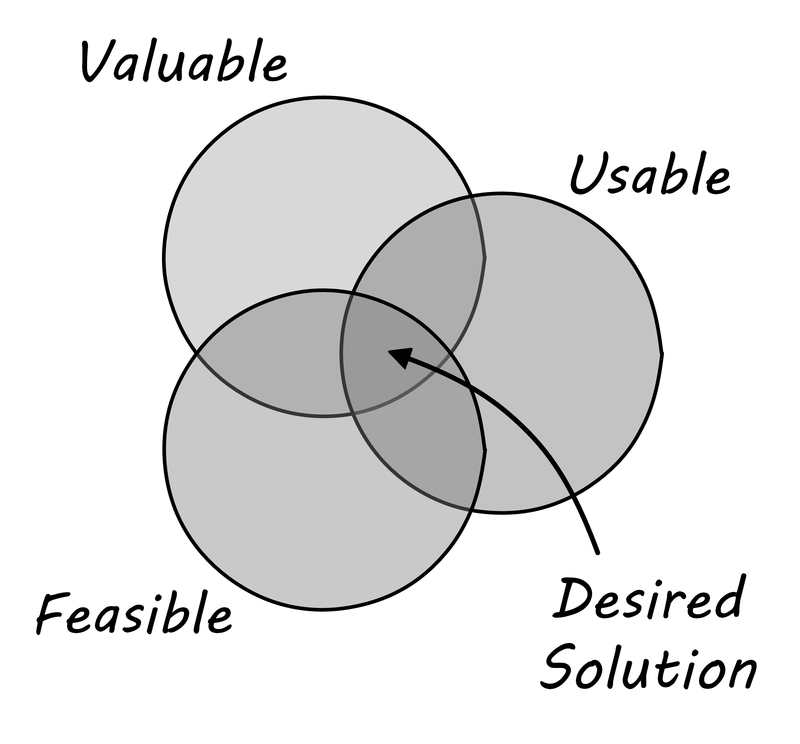
Finally, a word on the product manager. Scrum is prescriptive around the product owner role, but does not identify a role for product manager. This can lead to two people performing product management: a marketing-aligned “manager” responsible for high-level requirements, with the Scrum “product owner” attempting to translate them for the team. Marty Cagan warns against this approach, recommending instead that the product manager and owner be the same person, separate from marketing [50 pp. 7-8].
What is a product manager? A product manager is the one person in the whole organization who owns the product requirements effort. Requirements focus on the WHAT, which means it isn’t Development, which focuses on the HOW. And Marketing traditionally talks about the WHAT, but cannot necessarily decide what the WHAT should be. At least not at any useful level of detail [194].
Pragmatic Marketing
In the next chapter, we will consider the challenge of product discovery -— at a product level, what practices do we follow to generate the creative insights that will result in customer value?
4.4. Product discovery
Now that we have discussed the overall concept of product management and why it is important, and how product teams are formed, we can turn more specifically to the topic of product discovery and design. We have previously discussed the overall digital business context, as a startup founder might think of the problem. But the process of discovery continues as the product idea is refined, new business problems are identified, and solutions (such as specific feature ideas) are designed and tested for outcomes.
|
Note
|
In this book, we favor the idea that products are “discovered” as much or more than they are “designed.” But you will see both terms used throughout this chapter. See the parable the Flower and the Cog for an illustration of the difference. |
The presence of a section entitled “product discovery” in this book is a departure from other IT management textbooks. “Traditional” models of IT delivery focus on projects and deliverables, concepts we touched on in the last chapter section but that we will not explore in depth until later in the book. However, the idea of “product discovery” within the large company is receiving more and more attention. Even large companies benefit when products are developed with tight-knit teams using fast feedback.
|
Note
|
The term “intrapreneurship,” credited to Gifford Pinchot, means “entrepreneurship inside a large company.” |
For our discussion here, the challenge with the ideas of projects and deliverables is that they represent approaches that are more open loop, or at least delayed in feedback. Design processes do not perform well when feedback is delayed. System intent, captured as a user story or requirement, is only a hypothesis until tested via implementation and user confirmation.
4.4.1. Formalizing product discovery
It is humbling to see how bad experts are at estimating the value of features (us included).
Online Experimentation at Microsoft
In Chapter 3, we needed to consider the means for describing system intent. Even as a bare-bones startup, some formalization of this starts to emerge, at the very least in the form of test-driven development (see Product discovery tacit).

But, the assumption in our emergence model is that more formalized product management emerges with the formation of a team. As a team, we now need to expand “upstream” of the core delivery pipeline, so that we can collaborate and discover more effectively. Notice the grey box in Product discovery explicit.
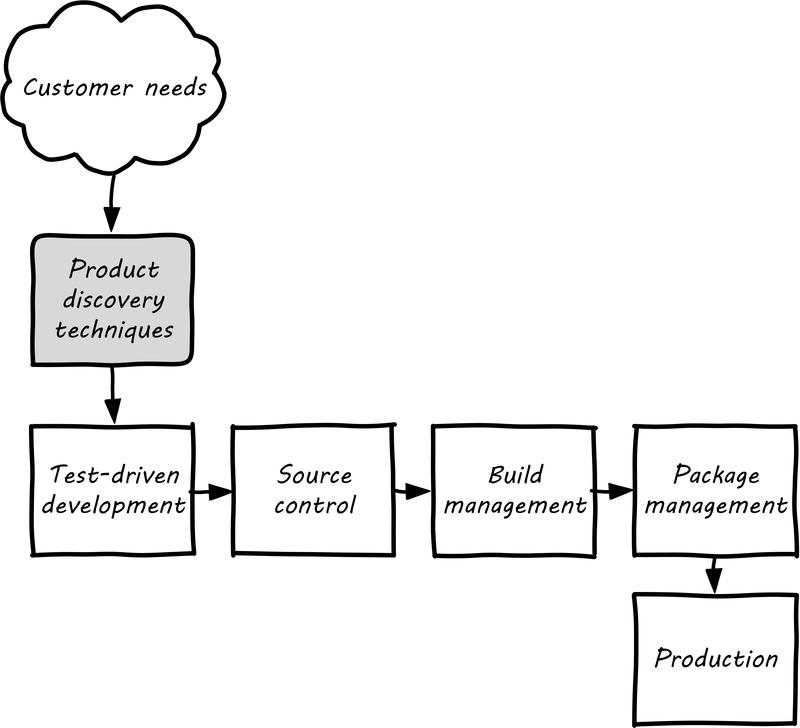
The most important foundation for your newly formalized product discovery capability is that it must be empirical and hypothesis-driven. Too often, product strategy is based on the Highest Paid Person’s Opinion (HiPPO). (Beware of HiPPO-based product discovery [4]).

The problem with relying on “gut feeling” or personal opinions is that people -— regardless of experience or seniority -— perform poorly in assessing the likely outcome of their product ideas. Some well known research on this topic was conducted by Microsoft’s Ronny Kohavi. In this research, Kohavi and team determined that “only about 1/3 of ideas improve the metrics they were designed to improve” [160]. As background, the same report cites that:
-
"Netflix considers 90% of what they try to be wrong”
-
“75% of important business decisions and business improvement ideas either have no impact on performance or actually hurt performance” according to Qualpro (a consultancy specializing in controlled experiments)
It is, therefore, critical to establish a strong practice of data-driven experimentation when forming a product team and avoid any cultural acceptance of “gut feel” or deferring to HiPPOs. This can be a difficult transition for the company founder, who has until now served as the de facto product manager.
A useful framework, similar to Lean Startup is proposed by Spotify, in the “DIBB” model:
-
Data
-
Insight
-
Belief
-
Bet
Data leads to insight, which leads to a hypothesis that can be tested (i.e., “bet” on — testing hypotheses is not free). We discuss issues of prioritization further in Chapter 5, in the section on cost of delay.
Don Reinertsen (whom we will read more about in the next chapter) emphasizes that such experimentation is inherently variable. We can’t develop experiments with any sort of expectation that they will always succeed. We might run 50 experiments, and only have 2 succeed. But if the cost of each experiment is $10,000, and the two that succeeded earned us $1 million each, we gained:
$ 2,000,000 $ — 500,000 ----------- $ 1,500,000
Not a bad return on investment! (See [220], Chapter 4, for a detailed, mathematical discussion, based on options and information theory).
Roman Pichler, in Agile Product Management with Scrum, describes “old-school” versus “new-school” product management as in Old school versus new school product management (summarized from [210], p. xii).
| Old school | New school |
|---|---|
Shared responsibility |
Single product owner |
Detached/distant product management |
Product owner on the Scrum team |
Extensive up-front research |
Minimal up-front work to define rough vision |
Requirements frozen early |
Dynamic backlog |
Late feedback due to lengthy release cycle |
Early & frequent releases drive fast feedback, resulting in customer value |
4.4.2. Product discovery techniques
There are a wide variety of techniques and even “schools” of product discovery and design; we will consider a few representatives in this chapter section. Of course, when you first started your journey in Chapter 1, you might also have used some of these techniques. But now that you are a team, you are formalizing and relying on these techniques. These techniques are not mutually exclusive; they may be complementary. But at the more detailed, digital product level, how do we develop hypotheses for testing, in terms of our products/services? We briefly mentioned User Story Mapping in our discussion of system intent. In product discovery terms, User Story Mapping is a form of persona analysis. But that is only one of many techniques. Roman Pichler mentions “Vision Box and Trade Journal Review” and the “Kano Model” [210 p. 39]. Here, let’s discuss:
-
“Jobs to be Done” analysis
-
Impact mapping
-
Business analysis & architecture
Jobs to be Done
Customers don’t want a quarter-inch drill. They want a quarter-inch hole.
If I’d asked the customer what they wanted, they would have said “faster horses.”
(apocryphal)
The “Jobs to be Done” framework was created by noted Harvard professor Clayton Christensen, in part as a reaction against conventional marketing techniques that:
"frame customers by attributes—using age ranges, race, marital status, and other categories that ultimately create products and entire categories too focused on what companies want to sell, rather than on what customers actually need" [62].
“Some products are better defined by the job they do than the customers they serve,” in other words. [268] This is in contrast to many kinds of business and requirements analysis that focus on identifying different user personas (e.g.,45-55 married Black woman with children in the house). Jobs to be Done advocates argue that “The job, not the customer, is the fundamental unit of analysis” and that customers “hire” products to do a certain job [60].
To apply the Job to be Done approach, Des Traynor suggests filling in the blanks in the following [268]:
Why do people hire your product?
People hire your product to do the job of -------— every ---------— when ----------. The other applicants for this job are --------, --------, and --------, but your product will always get the job because of --------.
Understanding the alternatives people have is key. It’s possible that the job can be fulfilled in multiple different ways. For example, people may want certain software run. This job can be undertaken through owning a computer (e.g.,having a data center). It can also be managed by hiring someone else’s computer (e.g.,using a cloud provider). Not being attentive and creative in thinking about the diverse ways jobs can be done places you at risk for disruption.
Impact mapping
Understanding the relationship of a given feature or component to business objectives is critical. Too often, technologists (e.g., software professionals) are accused of wanting “technology for technology’s sake.”
Showing the “line of sight” from technology to a business objective is, therefore, critical. Ideally, this starts by identifying the business objective. Gojko Adzic’s Impact Mapping: Making a big impact with software products and projects [5] describes a technique for doing so:
An impact map is a visualization of scope and underlying assumptions, created collaboratively by senior technical and business people.
Starting with some general goal or hypothesis (e.g.,generated through Lean Startup thinking), you build a “map” of how the goal can be achieved, or hypothesis can be measured. A simple graphical approach can be used, as in Impact map.

|
Note
|
Impact mapping is similar to mind mapping, and some drawing tools such as Microsoft Visio come with “Mind Mapping” templates. |
The most important part of the impact map is to answer the question “Why are we doing this?” The impact map is intended to help keep the team focused on the most important objectives, and avoid less valuable activities and investments.
For example, in the above diagram, we see that a bank may have an overall business goal of customer retention. (It is much more expensive to gain a new customer than to retain an existing one, and retention is a metric carefully measured and tracked at the highest levels of the business).
Through focus groups and surveys, the bank may determine that staying current with online services is important to retaining customers. Some of these services are accessed by home PCs, but increasingly customers want access via mobile devices.
These business drivers lead to the decision to invest in online banking applications for both the Apple and Android mobile platforms. This decision, in turn, will lead to further discovery, analysis, and design of the mobile applications.
The Business Analysis Body of Knowledge
One well-established method for product discovery is that of business analysis, formalized in the Business Analysis Body of Knowledge (BABOK), from the International Institute of Business Analysis [134].
The Business Analysis Body of Knowledge (BABOK) defines business analysis as (p. 442):
The practice of enabling change in the context of an enterprise
by defining needs and recommending solutions that deliver value to
stakeholders.
BABOK is centrally concerned with the concept of requirements, and classifies them thus:
-
Business requirements
-
Stakeholder requirements
-
Solution requirements
-
Functional requirements
-
Non-functional requirements
-
-
Transition requirements
BABOK also provides a framework for understanding and managing the work of business analysts; in general, it assumes that a Business Analyst capability will be established and that maturing such a capability is a desirable thing. This may run counter to the Scrum ideal of cross-functional, multi-skilled teams. Also as noted above, the term "requirements” has fallen out of favor with some Agile thought leaders.
4.5. Product design

Everyone designs who devises courses of action aimed at changing existing situations into preferred ones [250].
The art of making useful things beautiful and beautiful things useful.
Once we have discovered at least a direction for the product’s value proposition, and have started to understand and prioritize the functions it must perform, we begin the activity of design. Design, like most other topics in this book, is a broad and complex area with varying definitions and schools of thought. The Herbert Simon quote at the beginning of this section is frequently cited.
Design is an ongoing theme throughout the humanities, encountered in architecture (the non-IT variety), art, graphics, fashion, and commerce. It can be narrowly focused, such as the question of what color scheme to use on an app or web page. Or it can be much more expansive, as suggested by the field of design thinking. We’ll start with the expansive vision and drill down into a few interesting topics [5].
4.5.1. Design thinking
Design thinking is essentially a human-centered innovation process that emphasizes observation, collaboration, fast learning, visualization of ideas, rapid concept prototyping, and concurrent business analysis, which ultimately influences innovation and business strategy. [172]
Design Thinking
Design thinking is a recent trend with various definitions, but in general, combines a design sensibility with problem solving at significant scale. It usually is understood to include a significant component of systems thinking. As Tom Fisher, author of Designing Our Way to a Better World [91], notes:
We’ve been doing a lot of work in this area of “design thinking,” which takes the thought process and the methods that have been developed for millennia around the design of physical things — products, buildings, cities — and applies that to the so-called invisible world of design, which is all of the systems and organizations that are designed, but we don’t think of them as being designed. And we’re seeing a lot of these systems not working very well. [209]
Design thinking is the logical evolution of disciplines such as user interface design when such designs encounter constraints and issues beyond their usual span of concern. Although it has been influential on Lean UX and related works, it is not an explicitly digital discipline.
There are many design failures in digital product delivery. What is often overlooked is that the entire customer experience of the product is a form of design.
Consider for example Apple. Their products are admired worldwide and cited as examples of “good design.” Often, however, this is only understood in terms of the physical product, for example, an iPhone or a MacBook Air. But there is more to the experience. Suppose you have technical difficulties with your iPhone, or you just want to get more value out of it. Apple created its popular Genius Bar support service (see Apple Genius Bar [6]), where you can get support and instruction in using the technology.
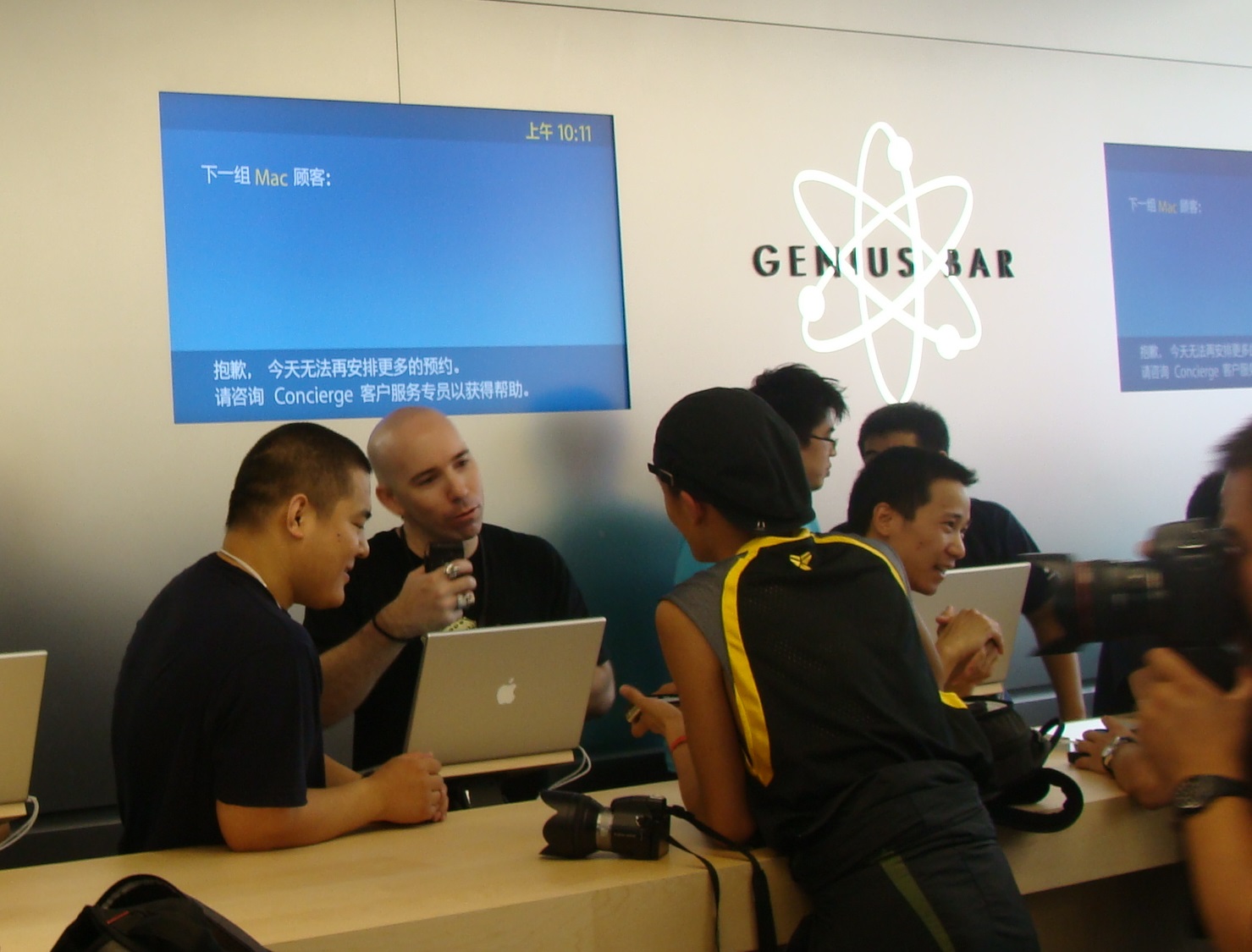
Notice that the product you are using is no longer just the phone or computer. It is the combination of the device PLUS your support experience. This is essential to understanding the modern practices of design thinking and Lean UX. As Jeff Sussna, author of Designing Delivery, notes, “In order to provide high-quality, digitally infused service, the entire delivery organization must function as an integrated whole.” [261 p. 18].
4.5.2. Hypothesis testing
The concept of hypothesis testing is key to product discovery and design. The power of scalable cloud architectures and fast continuous delivery pipelines has made it possible to test product hypotheses against real-world customers at scale and in real time. Companies like Netflix and Facebook have pioneered techniques like "canary deployments” and "A/B testing.”
In these approaches, two different features are tried out simultaneously, and the business results are measured. For example, are customers more likely to click on a green button or a yellow one? Testing such questions in the era of packaged software would have required lab-based usability engineering approaches, which risked being invalid because of their small sample size. Testing against larger numbers is possible, now that software is increasingly delivered as a service.
4.5.3. Usability and interaction
At a lower level than the holistic concerns of design thinking, we have practices such as usability engineering. These take many forms. There are many systematic and well-researched approaches to usability, interaction design [71, 135, 267, 18], visualization [52, 270] and related topics. All such approaches, however, should be used in the overall Lean Startup/Lean UX framework of hypothesis generation and testing. If we subscribe to design thinking and take a whole-systems view, designing for ease of operations is also part of the design process. We will discuss this further in Chapter 6. Developing documentation of the product’s characteristics, from the perspective of those who will run it on a day-to-day basis, is also an aspect of product delivery.
4.5.4. Parable: The Flower and the Cog
THUNK!
Hello. Where did you come from?
I fell. From that machine.
Machine?
Yes, that big loud thing that just passed by. And is now stopped over there.
Why is it stopped?
Because I am no longer with it. The machine needs me to function. I am called a “cog.” Where did you come from?
I am a flower. I grew from a seed.
You … grew?
Yes.
You mean, no-one planned or designed you?
Not that I know of. What does it mean to be “designed” or “planned"?
I am part of a greater whole. The need for me was understood when that greater whole was conceived. I was designed to fit a very particular place.
They had to try making me out of different metals, and different ways to make me. This took some time and effort -— longer than was planned, in fact. But it was always understood that there would need to be a cog in a certain place in the machine.
Interesting. So you will never be more than you are?
No. I will always be a cog. They might make a different machine, with different cogs, but they will not be me. Are you part of a machine?
No. I grew here because it suited me. I have continued to grow for a couple years. Eventually, I may grow 20 feet tall if the conditions remain good. I can adapt to other plants, and find my way around them to the sunlight and the water I need. Or I may stay smaller if I can’t get the sunlight I need. Or I may die.
Aren’t you part of a system that defines your purpose?
I don’t know. Sometimes I think I am a system myself, made up of my roots, stem, leaves, and flower. There are insects living on me who rely on me for food and shelter. And I have the freedom to grow into one of the largest trees in this area. That is worth it to me.
Interesting. Well, it is good you are growing where you are, and not 20 feet further in that direction.
Why?
Because when they find me, or replace me and fix the machine, it will continue to clear all the land over there.
Oh.
VOICES: “Hey Joe, here’s that gear the tractor must have thrown.”
“Good, grab it, and I’ll see if I can’t get it back in place at least temporarily until we can figure out why it happened.”
Bye.
Goodbye. Nice talking to you. Good luck.
Thanks. You too.
4.5.5. Product discovery versus design
Some of the most contentious discussions related to IT management and Agile come at the intersection of software and systems engineering, especially when large investments are at stake. We call this the “discovery versus design” problem.
Frequent criticisms of Lean Startup and its related digital practices are:
-
They are relevant only for non-critical Internet-based products (e.g.,Facebook and Netflix)
-
Some IT products must fit much tighter specifications and do not have the freedom to “pivot” (e.g.,control software written for aerospace and defense systems)
The parable in the previous section is meant to illustrate two very different product development worlds. Some product development is constrained by the overall system it takes place within. Other product development has more freedom to grow in different directions -— to “discover” the customer.
The cog represents the world of classic systems engineering -— a larger objective frames the effort, and the component occupies a certain defined place within it. And yet, it may still be challenging to design and build the component, which can be understood as a product in and of itself. Fast feedback is still required for the design and development process, even when the product is only a small component with a very specific set of requirements.
The flower represents the market-facing digital product that may “pivot,” grow and adapt according to conditions. It also is constrained, by available space and energy, but within certain boundaries has greater adaptability.
Neither is better than the other, but they do require different approaches. In general, we are coming from a world that viewed digital systems strictly as cogs. Subsequently, we are moving towards a world in which digital systems are more flexible, dynamic, and adaptable.
And, when digital components have very well understood requirements, usually we purchase them from specialist providers (increasingly “as a service”). This results in increasing attention to the “flowers” of digital product design since acquiring the “cogs” is relatively straightforward (more on this in the Chapter 8 section on sourcing).
4.6. Product planning
4.6.1. Product roadmapping and release planning
Some companies may notice that every specification they have ever prepared in the history of their company has had to change during product development, but they attribute this to human error and lack of discipline. They deeply believe that they can produce a good specification if only they try hard enough. You may recognize this as the classic thinking of an open-loop control system [219 p. 177] …
Managing the Design Factory
Creating effective plans in complex situations is hard. Planning a new product is one of the most challenging endeavors, one in which failure is common. As the Don Reinertsen quote above reflects, the historically failed approach (call it the "planning fallacy”) is to develop overly detailed (sometimes called “rigorous”) plans and then assume that achieving them is simply a matter of “correct execution” (see Planning fallacy).
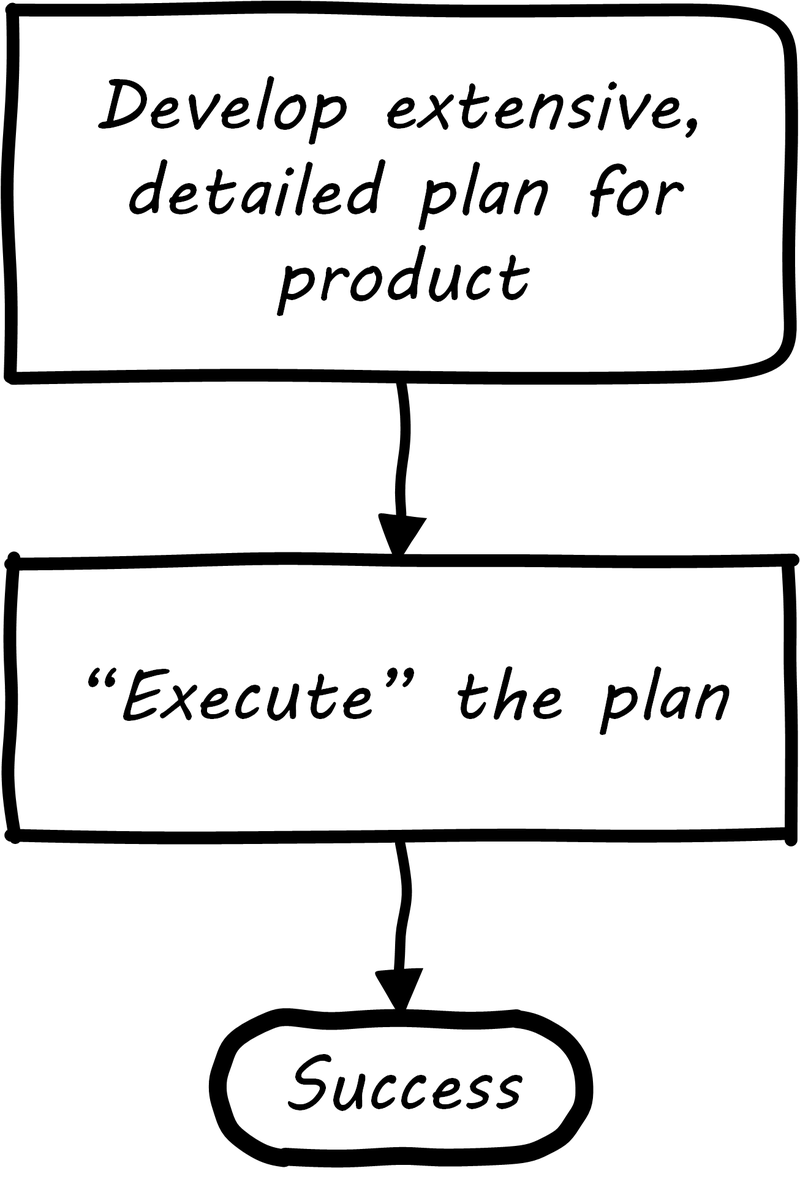
Contrast the planning fallacy with Lean Startup, which emphasizes ongoing confirmation of product direction through experimentation. In complex efforts, ongoing validation of assumptions and direction is essential, which is why overly plan-driven approaches are falling out of favor. However, some understanding of timeframes and mapping goals against the calendar is still important. Exactly how much effort to devote to such forecasting remains a controversial topic with digital product management professionals, one we will return to throughout this book.
Minimally, a high-level product roadmap is usually called for: without at least this, it may be difficult to secure the needed investment to start product work. Roman Pichler recommends the product roadmap contain:
-
Major versions
-
Their projected launch dates
-
Target customers and needs
-
Top three to five features for each version [210 p. 41].
More detailed understanding is left to the product backlog, which is subject to ongoing “grooming”, that is, re-evaluation in light of feedback.
4.6.2. Backlog, estimation, and prioritization
… companies often create complex prioritization algorithms that produce precise priorities based on very imprecise input data. I prefer the simple approach. To select between two almost equivalent choices creates great difficulty and little payoff. Instead, we should try to prevent the big, stupid mistakes. This does not require precision [220 p. 192].
Principles of Product Development Flow
The product discovery and roadmapping activity ultimately generates a more detailed view or list of the work to be done. As we previously mentioned, in Scrum and other Agile methods this is often termed a backlog. Both Mike Cohn and Roman Pichler use the DEEP acronym to describe backlog qualities [67 p. 243, 210 p. 48]:
-
Detailed appropriately
-
Estimated
-
Emergent (feedback such as new or changed stories are readily accepted)
-
Prioritized
The backlog should receive ongoing “grooming” to support these qualities, which means several things:
-
Addition of new items
-
Re-prioritization of items
-
Elaboration (decomposition, estimation, and refinement)
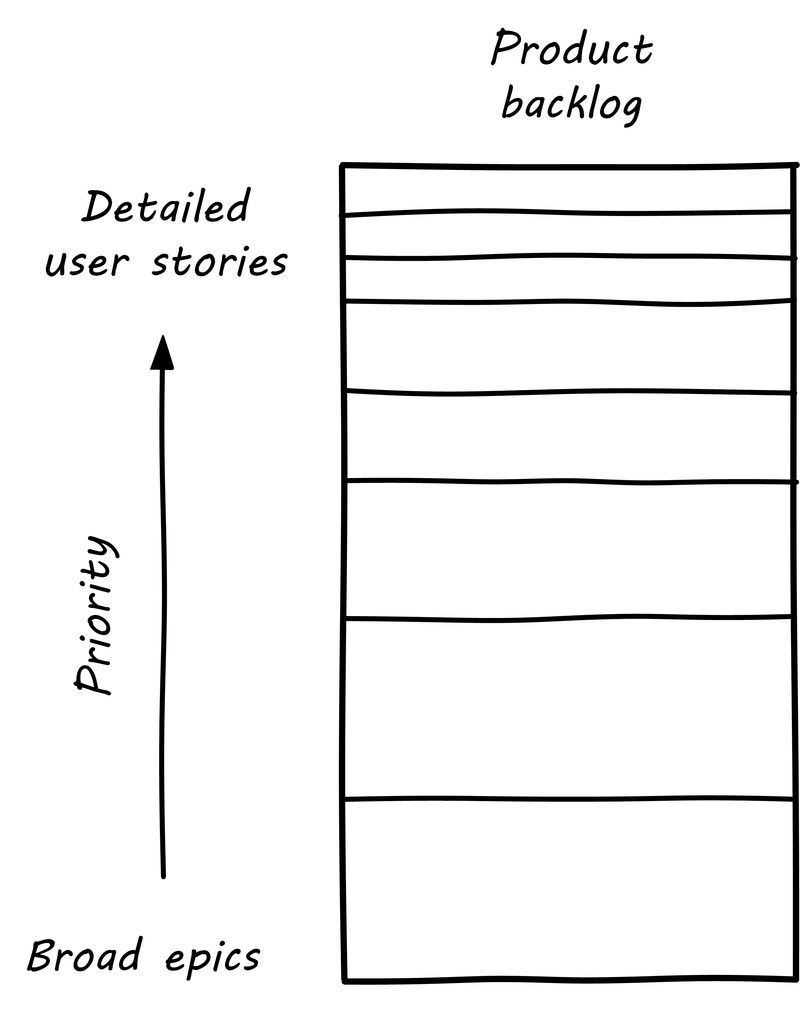
When “detailed appropriately,” items in the backlog are not all the same scale. Scrum and Agile thinkers generally agree on the core concept of "story,” but stories vary in size (see Backlog granularity and priority footnote:[similar to [210]), with the largest stories often termed “epics.” The backlog is ordered in terms of priority (what will be done next) but, critically, it is also understood that the lower-priority items, in general, can be larger grained. In other words, if we visualize the backlog as a stack, with the highest priority on the top, the size of the stories increases as we go down. (Reinertsen terms this progressive specification; see [219 pp. 176-177] for a detailed discussion).
Estimating user stories is a standard practice in Scrum and Agile methods more generally. Agile approaches are wary of false precision and accept the fact that estimation is an uncertain practice at best. However, without some overall estimate or roadmap for when a product might be ready for use, it is unlikely that the investment will be made to create it. It is difficult to establish the economic value of developing a product feature at a particular time if you have no idea of the cost and/or effort involved to bring it to market.
At a more detailed level, it is common practice for product teams to estimate detailed stories using “points.” Mike Cohn emphasizes, “Estimate size, derive duration” ([66], p. xxvii). Points are a relative form of estimation, valid within the boundary of one team. Story point estimating strives to avoid false precision, often restricting the team’s estimate of the effort to a modified Fibonacci sequence, or even T-shirt or dog sizes [66 p. 37] as shown in Agile estimating scales [7].
Mike Cohn emphasizes that estimates are best done by the teams performing the work [66 p. 51]. We’ll discuss the mechanics of maintaining backlogs in Chapter 5, Work Management.
| Story point | T-shirt | Dog |
|---|---|---|
1 |
XXS |
Chihauha |
2 |
XS |
Dachshund |
3 |
S |
Terrier |
5 |
M |
Border Collie |
8 |
L |
Bulldog |
13 |
XL |
Labrador Retriever |
20 |
XXL |
Mastiff |
40 |
XXXL |
Great Dane |
Backlogs require prioritization. In order to prioritize, we must have some kind of common understanding of what we are prioritizing for. Mike Cohn, in Agile Estimating and Planning, proposes that there are four major factors in understanding product value:
-
The financial value of having the features
-
The cost of developing and supporting the features
-
The value of the learning created by developing the features
-
The amount of risk reduced by developing the features [66 p. 80]
In Chapter 5 we will discuss additional tools for managing and prioritizing work, and we will return to the topic of estimation in Chapter 8.
4.7. Conclusion
As with most other chapters in this book, this brief survey cannot do justice to such a broad field.
Product-centric thinking is at the core of delivering digital value. Without a clear understanding of the product and its context, investments of time and resources are at risk.
Product management requires close collaboration between individuals of different skills. Team structures, practices, and culture are critical factors for success. Establishing an experimental mindset is essential; research shows that product ideas must be validated as expert opinion is of minimal value.
Product discovery and design is a broad field; design thinking is an important influence, as design spans more than just the user interface.
4.7.1. Discussion questions
-
Can you think of examples from your own experience where you or someone else confused “output” (e.g.,deliverable) with “outcome"?
-
What is your experience with being on teams? Have you ever been on a team where people felt the psychological safety to take risks? Or the opposite?
-
Can you identify two or three distinct features (as defined above) for a commercial product such as Facebook or Netflix? Try to “reverse engineer” features that might have been individual areas of investment.
-
Can you think of any components (as defined above) you will need?
4.7.2. Research & practice
-
If you have team product ideas from previous discussions, consider them in terms of the Cagan/Patton questions and prepare an analysis:
-
Is it valuable?
-
Is it usable?
-
Is it feasible?
-
-
Identify and analyze a situation where “design” requires a broad, design-thinking understanding of both physical products as well as the service interactions surrounding it. Present to your class.
-
Review the Scaled Agile Framework’s descriptions of features and user stories. Document one feature consisting of several stories for your product.
-
Research Behavior-Driven Development and consider its potential value for you.
4.7.3. Further reading
Books
-
Gojko Adzic, Impact Mapping: Making a Big Impact with Software Products and Projects
-
Chris Bank and Jerry Cao, The Guide to Usability Testing
-
Marty Cagan, Inspired: How To Create Products Customers Love
-
Tom Fisher, Designing Our Way to a Better World
-
Jeff Gothelf, Lean UX: Applying Lean Principles to Improve User Experience
-
Thomas Lockwood, Design Thinking: Integrating Innovation, Customer Experience, and Brand Value
-
Jeff Patton, User Story Mapping: Discover the Whole Story, Build the Right Product
-
David Rock and Heidi Grant, Why Diverse Teams Are Smarter
-
Ken Rubin, Essential Scrum: A Practical Guide to the Most Popular Agile Process
-
Chris Sims and Hilary Louise Johnson, Scrum: a Breathtakingly Brief and Agile Introduction
-
Jeff Sussna, Designing Delivery: Rethinking IT in the Digital Service Economy
Articles
Videos
-
Alistair Cockburn, Why Agile Works
Professional